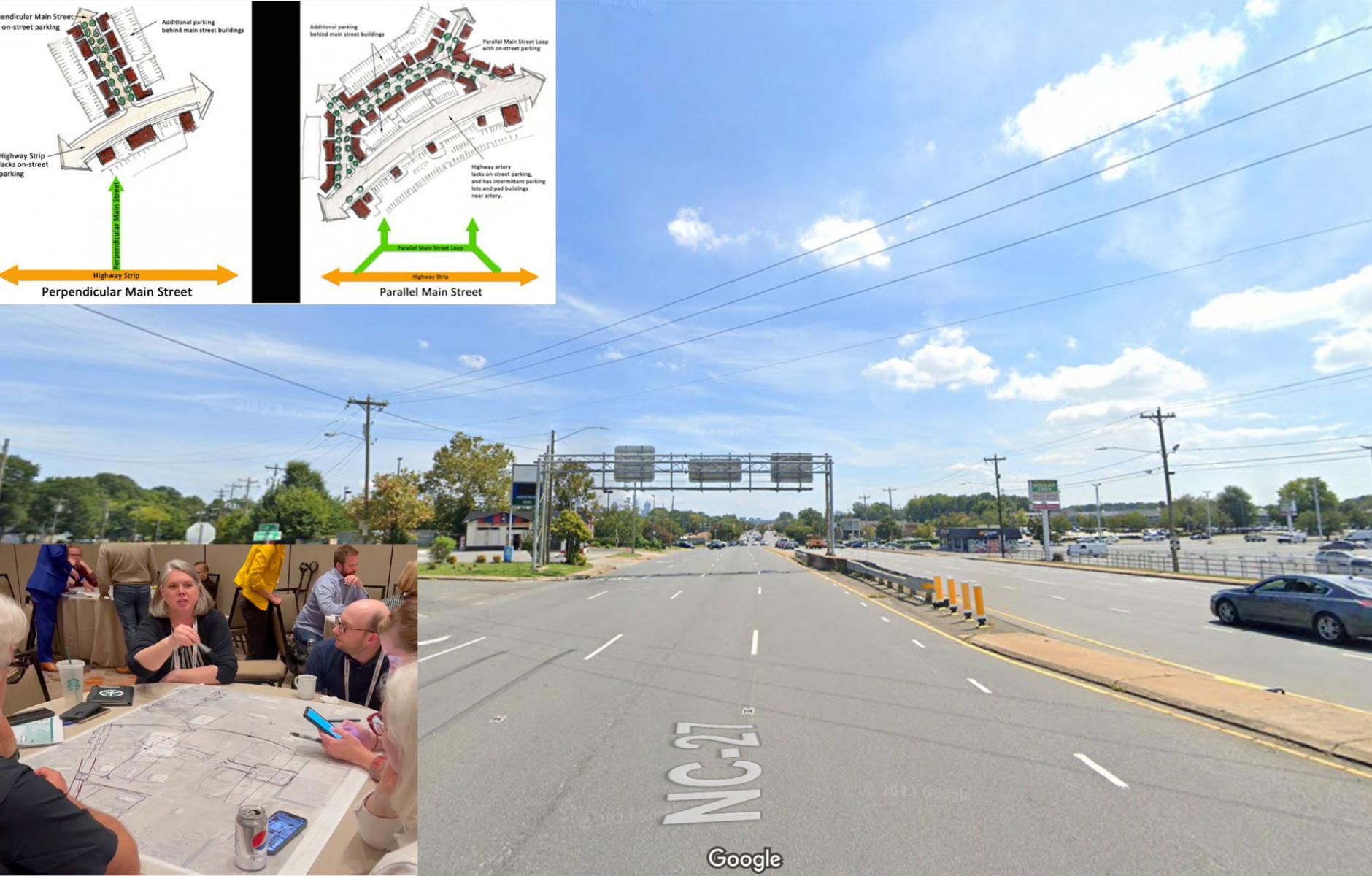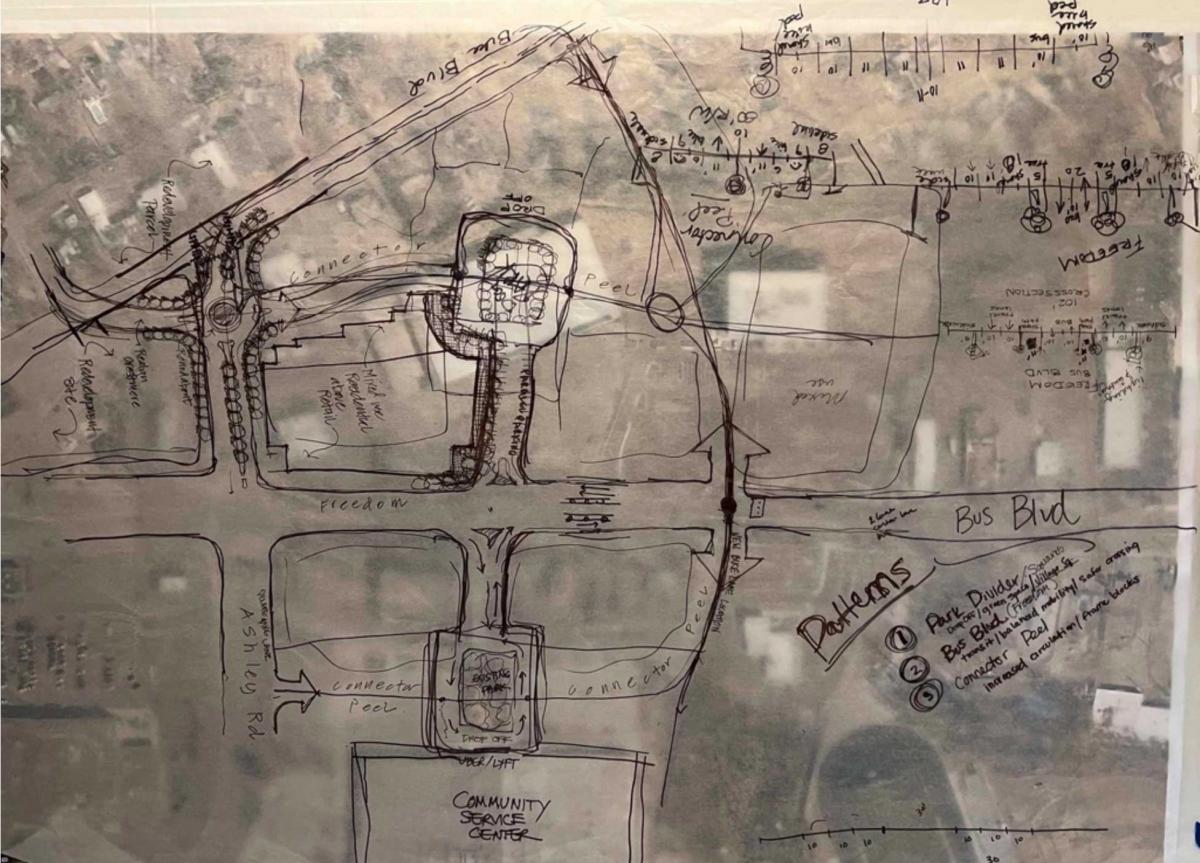
A pattern language applied to a suburban strip
A Pattern Language by Christopher Alexander is one of the best-selling architectural books of all time, inspiring many urbanists with ideas related to community design. Yet its land-use influence is limited by the difficulty of translating the ideas into comprehensive plans and zoning codes. Also, the book’s 253 patterns were viewed as complete, with few attempting to add new ideas.
And yet Alexander, who died in 2022, has been more influential in software engineering and other fields. A team of new urbanists sought to change that reality by leading a workshop in Charlotte, North Carolina, that applied a pattern language approach to an automobile-oriented, suburban corridor. Participants freely named and described patterns as needed to create plans.
According to the leaders, “The participants included planners, architects, elected officials, nonprofit officials, and citizen activists from the USA and internationally.” Approximately sixty individuals worked in eleven teams during the event at CNU 31 in June (the theme of the Congress was corridors). A recent report demonstrated the potential of systematically using Alexander’s ideas in a complex suburban retrofit.
Freedom Drive, northwest of downtown, is a major arterial road with up to eight lanes, dominated by automobiles, dangerous to pedestrians, and needing revitalization. It is bisected by Interstate 85 and includes a former shopping mall now used by the government and other organizations. The corridor has large setbacks, and nearby houses are poorly connected to the stores and services. In other words, the corridor is extremely challenging.
In an afternoon workshop, the teams suggested patterns, supplemented by rough plans. Participants recorded 84 patterns, which are hard to digest initially, but a clear picture emerges by grouping similar patterns together. The following are primary ideas from the seven dozen patterns:
Connect a street and block network
The most common idea was to create networks of small blocks and streets and/or pedestrian pathways. Along Freedom Drive, there is little opportunity to walk and few safe paths to take you from one location to another. The participants rightly perceived the first task as building a network for walking and multimodal travel. They gave various names for these patterns: “stitch together,” “street network with small blocks,” “finish the grid,” “walkable grid,” “new street connections,” and so on. “Use a new network of streets to connect the currently fragmented urban fabric, including streets that cut through the existing mall site,” one team states. Virtually every team drew a network of small blocks.
Many suggested patterns focused on pedestrian networks and walkways in particular. These were named as “pedestrian network,” “orthogonal pedestrian network,” “pedestrian sanctuary,” “network of pedestrian crossings,” and “generous sidewalks.”

It’s not obvious how such networks would be established in the barren suburban soil of an automobile-oriented corridor. However, suggestions of methodological patterns for establishing walkable street networks were promising. An aerial view of Freedom Drive shows numerous parking lots spread throughout the corridor. A closer examination reveals that drive lanes separate the parking and, individually, the lots are the size of small city blocks. Several teams picked up on this: “Use the existing pattern of parking lots and drive lanes to establish new walkable streets and perimeter buildings,” one team explains. The pattern is called “follow the parking lots.”
Transform Freedom Drive into a boulevard
Although Freedom Drive is hard to imagine as walkable, participants offered many patterns for transforming the thoroughfare. For example, the “bus boulevard” pattern states: “Re-structure Freedom Drive to be more multi-modal, with bus turnouts and bus stops and safer and more comfortable pedestrian crossings.” The one simply called “boulevard” advises: “Transform Freedom Drive into a walkable mixed-mode boulevard, with narrower lanes and safe pedestrian crossings. Reduce lane widths, curb cuts, and vehicular speeds for outer lanes.”
Redevelop the mall site
Many teams focused on transforming the former shopping mall, which is used for government offices. This inspired pattern suggestions, including the one called “mall retrofit node,” suggested by Team 9. “Make the mall area the largest node in the system, retrofitting the existing building and establishing areas for a new mixed-use neighborhood center.” One team suggested keeping the mall building but carving out a street through the middle to reduce the building’s scale and make the area more walkable.
Create nodes of activity
The area currently lacks mixed-use walkable centers or any point of focus for pedestrians. Walkable cities and towns have centers, such as downtowns, main streets, squares, and plazas. Most of the teams offered pattern ideas to fill that gap. One team suggested there should be some kind of “public space every 200 feet.” Another team suggested “activity nodes” throughout the area. Christopher Alexander’s pattern “interchange” was cited to “Create connected, mixed-use interchanges in the web of transportation.” That sounds like transit-oriented development.
Some patterns are more specific, citing a “main street” as a specific node type. “Streets are ‘urban rooms’ that need spatial definition and clear edges rather than extending endlessly in perfectly straight lines. They can be enclosed by terminating in T-intersections or by using curves and bends,” argues one team, describing a pattern called “Main Street that encloses.”

Build housing
Residential subdivisions are located along the corridor, but they are poorly connected to commercial properties, which tend to lack housing. Many teams proposed adding living spaces to currently single-use business sites, and making better connections to the existing residential. According to one team, new and better-connected housing would support pedestrian-oriented retail. The pattern called “Broaden Residential” was proposed: “Connect to existing residential areas, and bring in residential to the current mall site.” One team cities Alexander’s pattern of a community with 7,000 people. “Give local control to communities of 5,000 to 10,000 persons,” he advises.
Reform parking
Parking was a significant theme because the corridor has so many surface lots. Alexander had a pattern, “nine percent parking,” stipulating, “Do not allow more than 9 percent of the land in any given area to be used for parking.” That would be difficult to achieve, but teams suggested that on-street parking be supplemented with structured parking, allowing for much higher densities.
Connect green spaces and corridors
Highways and other automobile infrastructure in the corridor often interrupt existing greenways. It was suggested that greenways be connected across the Interstate and through larger blocks, breaking them into smaller and more connected blocks. To that end, a network of parks could be created. Trees should line every street. Stormwater could be handled through a greenway.
Include architectural highlights
Architectural patterns were suggested, including terminated vistas and the tapering outward of a main pedestrian axis as it leads to a focal point at one end. Gateways to neighborhoods and centers could be celebrated with sculptures or other entry features.
Provide bicycle infrastructure
Bicycling could be promoted through a “bike boulevard,” bike lanes, and protected bike paths. One team suggested creating a perpendicular new bike pathway to cross the neighborhood and connect to the main street.
Use alleys creatively
Several patterns were suggested for alleys as shared spaces and sites for expanded commercial activity. “Consider alleys as places where cars move very slowly, and pedestrians and bikes can share the space, perhaps with amenities like benches and play areas,” according to one pattern.
Develop on a human scale
Some of the patterns were generally new urbanist, like “human-scale development,” “Welcoming streetscapes,” and “new mixed-use development.” A pattern of “blocks and buildings are smaller and more easily related to pedestrians” suggests incremental development. “Wide sidewalks and facades with active uses and streets creating a sense of enclosure” describes the aim of good urbanism.
The impressive aspect of this document is that the process seems more freewheeling and less predetermined than many professional charrettes. Participants were empowered to focus on any part of the corridor and apply any patterns. The patterns are stated in everyday language—perhaps due to the wide range of participants. If a series of similar workshops were conducted on many urban place types, an expanded pattern language could emerge—especially if similar patterns are combined under apt titles. This approach seems like it could yield robust solutions to the built environment and develop a useful charrette technique.
The mini-charrette and workshop began with presentations by Erin Gillespie, Michael Mehaffy, Laurence Qamar, and Neal Payton, who explained the pattern language approach at the June, 2023, event. The group helped facilitate the teams, who gathered at tables with large corridor maps to draw and brainstorm during the second half of the event. Public Square reported on Qamar’s presentation, which offered four models for transforming an automobile-oriented commercial strip (sometimes called a “stroad.”)
Download the full report here.




